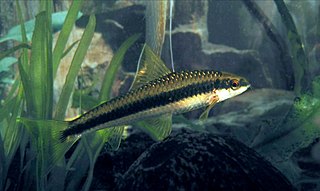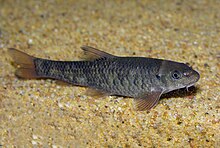
Cyprinidae is a family of freshwater fish commonly called the carp or minnow family, including the carps, the true minnows, and their relatives the barbs and barbels, among others. Cyprinidae is the largest and most diverse fish family, and the largest vertebrate animal family overall, with about 3,000 species; only 1,270 of these remain extant, divided into about 200 valid genera. Cyprinids range from about 12 mm (0.5 in) in size to the 3 m (9.8 ft) giant barb. By genus and species count, the family makes up more than two-thirds of the ostariophysian order Cypriniformes. The family name is derived from the Greek word kyprînos.

Rasbora is a genus of fish in the family Cyprinidae. They are native to freshwater habitats in South and Southeast Asia, as well as southeast China. A single species, R. gerlachi, is only known from an old specimen that reputedly originated from Africa (Cameroon), but this locality is considered doubtful. They are small, up to 17 cm (6.7 in) long, although most species do not surpass 10 cm (4 in) and many have a dark horizontal stripe.

Danio is a genus of small freshwater fish in the family Cyprinidae found in South and Southeast Asia, commonly kept in aquaria. They are generally characterised by a pattern of horizontal stripes, rows of spots or vertical bars. Some species have two pairs of long barbels. Species of this genus consume various small aquatic insects, crustaceans and worms.

Glyptothorax is a genus of catfishes order Siluriformes of the family Sisoridae. It is the most species-rich and widely distributed genus in the family with new species being discovered on a regular basis. These species are distributed in the Black Sea basin, northern Turkey, south and east to the Yangtze River drainage in China and south throughout Indo-China to Java, Indonesia. They are found in Asia Minor and southwards to Southeast Asia. The genus is very diverse in the Indian subcontinent. Southeast Asian species tend to have restricted distributions.

Capoeta, also known as scrapers, is a genus of fish in the family Cyprinidae found in Western Asia. The distribution extends from Turkey to the Levant, to Transcaucasia, Iraq, Turkmenistan, in Armenia, particularly in lake Sevan and northern Afghanistan. This genus is most closely related to Luciobarbus and in itself is divided into three morphologically, biogeographically and genetically distinct groups or clades: the Mesopotamian clade, the Anatolian-Iranian clade and the Aralo-Caspian clade.
Eidinemacheilus smithi, also known as the Zagroz blind loach, is a species of loach in the family Nemacheilidae. This cavefish is endemic to an aquifer in the Karun River drainage in the Zagros Mountains of Iran.

Schistura is a genus of fish in the stone loach family Nemacheilidae native to the streams and rivers of the southern and eastern Asia. Some of these species are troglobitic.
Squalius is a genus of fish in the family Cyprinidae found in Europe and Asia. Hybridization is not rare in the Cyprinidae, including this genus. S. alburnoides is known to be of ancient hybrid origin, with the paternal lineage deriving from a prehistoric species related to Anaecypris; the latter mated with ancestral S. pyrenaicus. Present-day S. alburnoides mates with sympatric congeners of other species.
Typhlogarra widdowsoni or Garra widdowsoni, the Iraq blind barb or Haditha cave garra, is a species of cyprinid fish endemic to underground water systems near Haditha in Iraq. Although traditionally placed in its own genus Typhlogarra, this is not supported by genetic evidence, leading to its move to Garra. This cavefish is considered critically endangered because of water extraction, which has lowered the groundwater level. Once abundant, a survey in 2012 found that it now was very rare. Another species from the same place, Caecocypris basimi, may already be extinct. The only other known cavefish in Iraq is Eidinemacheilus proudlovei.

Danio erythromicron, often known as emerald dwarf danio and emerald dwarf rasbora, is a species of cyprinid fish which is endemic to Inle Lake in Myanmar.

Labeoninae is a doubtfully distinct subfamily of ray-finned fishes in the family Cyprinidae of order Cypriniformes. They inhabit fresh water and the largest species richness is in the region around southern China, but there are also species elsewhere in Asia, and some members of Garra and Labeo are from Africa. They are a generally very apomorphic group, perhaps the most "advanced" of the Cyprinidae. A common name for these fishes is labeonins or labeoins.

Psilorhynchus is a genus of fish in the family Psilorhynchidae native to South Asia. This genus is the only member of its family. The members of Psilorhynchus are small benthic fishes which occur in rivers and streams with fast to swift currents, hence they are often referred to a torrent minnows. They are distributed in southern Asia, in the Indo-Burma region and the Western Ghats.

The least rasbora or exclamation point rasbora is a species of ray-finned fish in the genus Boraras, native to freshwater habitats in mainland southeast Asia. This species is very small, ranging from 12 to 16 mm.

Hypselobarbus is a genus of fish in the family Cyprinidae endemic to India.
Aborichthys is a genus of stone loaches found in streams of India with one species also found in Myanmar.
Paracobitis is a genus of Asian stone loaches.

Pethia is a genus of small freshwater fish in the family Cyprinidae native to South Asia, East Asia and Mainland Southeast Asia. Some species are commonly seen in the aquarium trade. The name Pethia is derived from the Sinhalese "pethia", a generic word used to describe any of several small species of cyprinid fishes. Most members of this genus were included in Puntius, until it was revised in 2012.
Garra magnidiscus is a species of cyprinid fish in the genus Garra. Identified in 2013, Garra m. is found in the Upper Siang district of Arunachal Pradesh where is it is known locally as Ngop. The name magnidiscus refers to a distinctive large adhesive disc found in the posterior region of its mouth.
Garra alticaputus is a species of cyprinid fish in the genus Garra described from the Dikrong River at Boorum village Itanagar, Arunachal Pradesh, India.
Garra minimus is a species of cyprinid fish in the genus Garra described from the Ranga River, Lower Subansiri District, Arunachal Pradesh, India.















